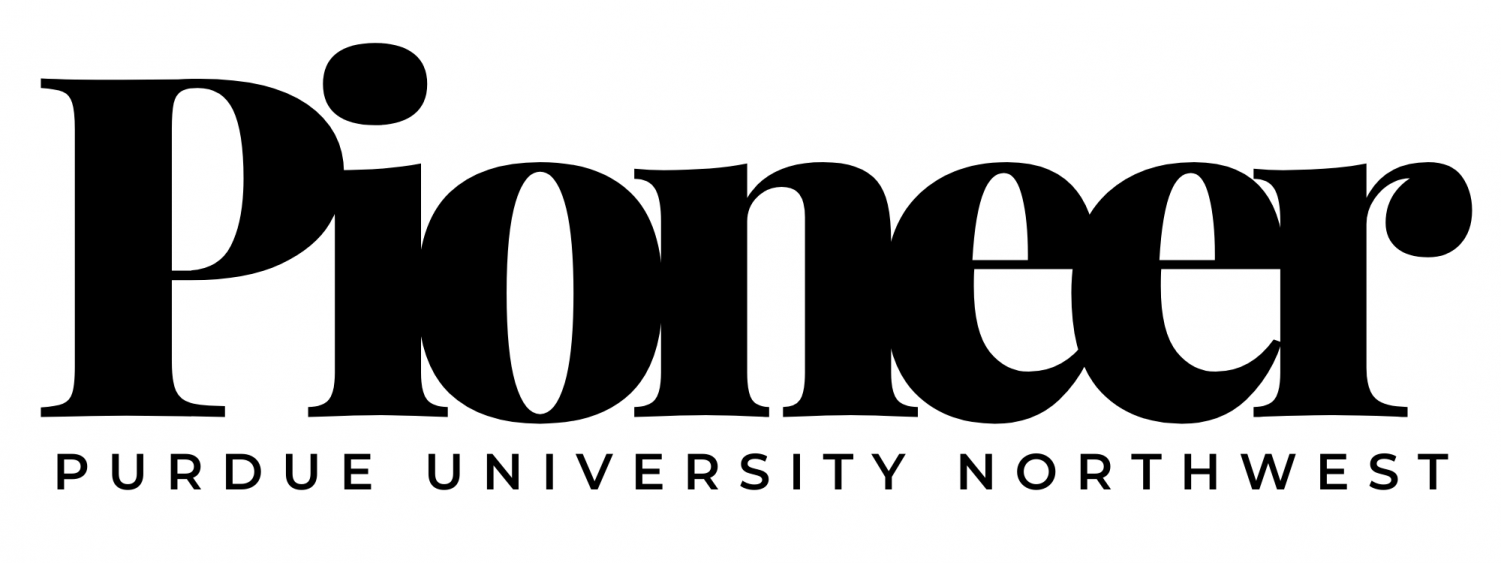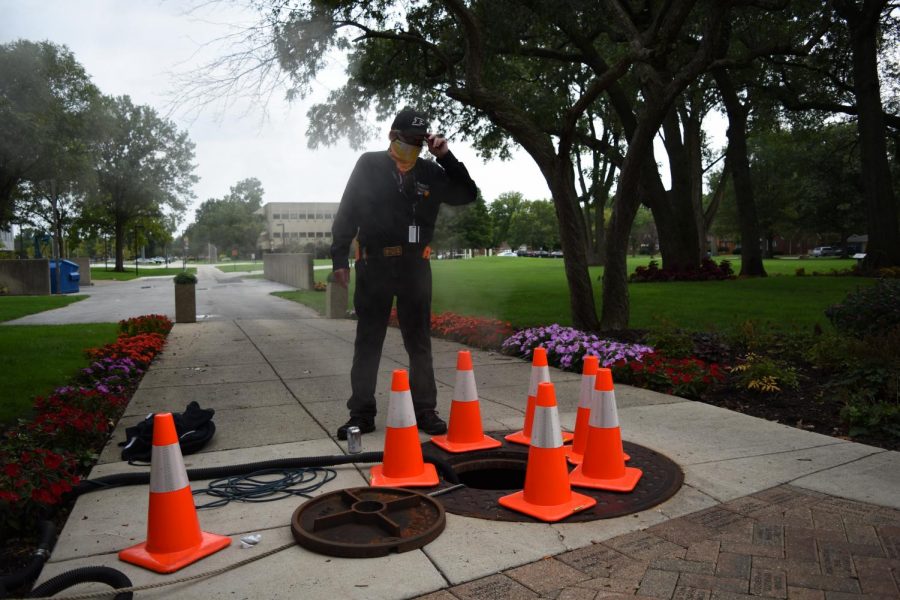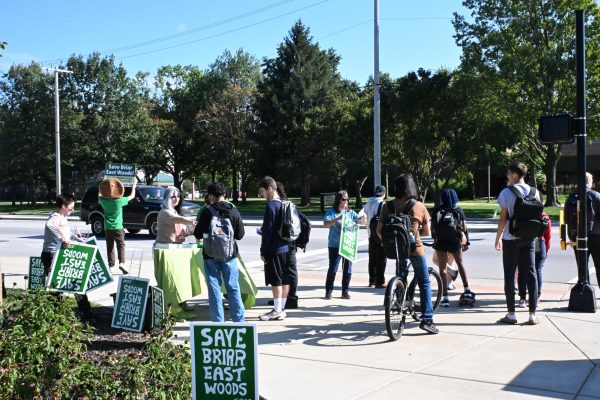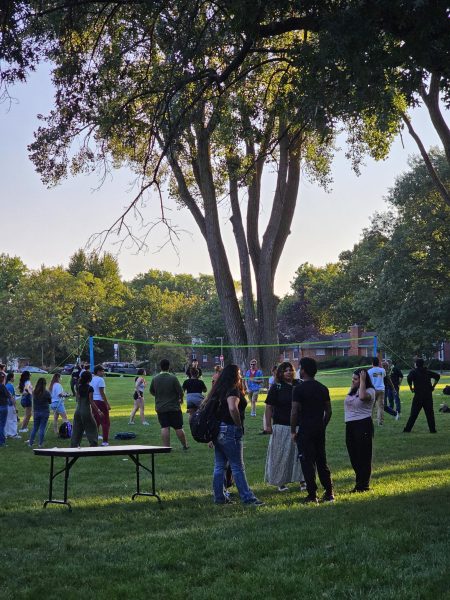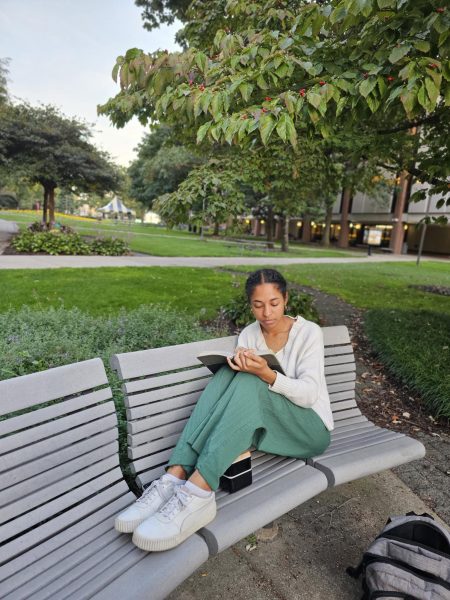Behind the scenes, a team of ‘invisible’ staff keep campuses running
Edwin Rodriguez starts his mornings at PNW at six, disinfecting, organizing and cleaning his assigned rooms, all before the student body and faculty arrive.
“I think of myself as one of those elves from that old cartoon,” [The Shoemaker and the Elves, 1935] said Rodriguez. “You probably don’t remember the one, but after the shoemaker guy goes to bed these elves come into his shop and clean the place and make all the shoes. The shoemaker wakes up and just goes on with his day, like nothing happened… No-one thinks about what we do, no-one really sees it.”
Rodriguez is one of the 49 custodians across Hammond and Westville that keeps the campuses clean, organized and functioning. Their work falls under building services, a department found north of the parking garage, hidden away from the Hammond Campus.
Apart from their custodial operations, building services is responsible for event set-ups, equipment and furniture moves and recycling and waste removal. According to last year’s building service report, these employees organized 1,087 rooms, moved 539 offices and set up 1,971 events across both campuses. Rodriguez did 360 of those events alone.
There are 37 midnight staff and four evening staff between the two campuses who fully clean 17 buildings with approximately 843,606 cleanable square feet. Two other buildings are handled by maintenance contractors. Six day staff and two afternoon staff between the two campuses maintain the daily servicing, university moves, event support, recycling and service calls for 19 buildings.
“They are very hardworking people,” said Director of Building Services Karen Sullivan. “We are one department with two locations, and I could not do what I do if it weren’t for the staff. They are the true rock stars.”
The magnitude of work that building services performs only intensified after the pandemic.
“When the pandemic happened, we immediately drafted new procedures for cleaning high touch areas,” said Jacob Lenson, assistant vice chancellor for campus planning, infrastructure and facilities. “We prioritized event set up time to clean more, invested in new equipment like misters that disinfect more surface area in less than 30 seconds of contact, installed sanitizing stations in every building and doorway and tried to shed some light on what the critical mission of the university is: Providing an environment where students can learn safely.”
On top of their normal routine, building services had to intensify disinfecting and de-densify the campus. This meant moving all furniture to a safe, socially distant six feet apart and removing half of the seats in classrooms.
“We are essential personnel. We were here during the whole lockdown… All of the products we were using were already at the level that was asked by the CDC. It was just a matter of increasing the amount of cleaning that we were doing,” said Sullivan. “The de-densifying was a lot of work. We had to cut the capacity of classrooms, lounges and public areas down to 50 percent. That took a lot of manpower.”
Building services keeps the school running, unnoticed and sometimes unappreciated.
“You have a mix of students here,” said Rodriguez. “Some students can be rude, disrespectful. One student started yelling at me and some of my coworkers. He looked lost, so I asked if he needed help getting somewhere and he yelled at us for how we were doing our job.… We have been working our butts of the past four months.… And some students can be very messy. Especially the bathroom. The trashcan will be right there, and they will leave garbage right next to it. Some students do not even flush the toilet. Professors too!”
Building services wants students to succeed just as much as instructors do, sometimes more.
“I look at the students from the position of a father,” said Rodriguez. “Sometimes I’ll see students in the cafeteria who don’t have enough money for their food. I will pay for it. I wouldn’t want my kid to have to walk off to their next class hungry.”
Rodriguez had very little knowledge of building services and custodial work when he first applied. He came with a very unique set of skills.
“I used to be in the restaurant business down in Puerto Rico at Palmas Del Mar,” said Rodriguez. “I used to be a fruit carver. I was also a jazz musician.… I did that for 17 years.”
Rodriguez used to create elaborate decorative carvings of fruit as centerpieces for resort events, as well as being one of the live performers with the hotel’s jazz band.
He could not have been happier to leave.
“You are going to think I am crazy when I say this but, I love my job here,” said Rodriguez. “I get to meet so many different people and life at the resort was stressful. Here I can do my job how I want to do it, as long as I get the job done.”
Rodriguez is in his late 50s, has been with building services for 23 years and has no plans to retire any time soon.
Building services is not the only department that performs this behind-the-scenes work. There are 36 other workers that make up Hammond’s University Services department. This includes grounds and maintenance.
“It’s the nature of the profession, said Hammond Campus Maintenance Service Manager Robert Widiger. “If you are being noticed it is probably because there is something wrong.”
Widiger generally oversees a team of six—now down to four—handymen. This team works 40 hours a week, Monday through Friday, but has been clocking in overtime since the pandemic. Paper towel dispensers, hand sanitizing stations and more than 300 plexiglass shields needed to be installed across the Hammond Campus.
“People have been balancing heavy workloads, running around exhausted,” said Widiger. “It doesn’t matter all that much about how many students are returning to campus. There is always going to be the same amount of light and plumbing fixtures, heating and cooling filter changes.”
Hammond Maintenance deals with furniture moves, plumbing fixtures, bulb replacements, filter changes, lock and door maintenance, art installation and heating and cooling across 21 buildings.
It is routine work. The team generally deals with the same problems every day. The pandemic, however, has been stirring up some odd new issues. Maintenance has noticed that faculty and students have been using their feet to flush the toilets a lot more – and a bit too aggressively.
“We’re seeing a lot more crooked plumbing, leakage and footprints on the walls with the virus. I get it, people do not want to touch the handle. But you do not need to stomp on the thing,” said Widiger.
Work for the Grounds Department has not changed much since the pandemic. Their work is mostly outside. A team of six and a handful of student workers trim trees, prune shrubs, manage irrigation systems, spray billions and trillions of weeds, deal with pests inside and out and tackle the beastly job of snow removal. Their work covers approximately 110 acres of land across the Hammond Campus. Westville deals with 260 acres.
Even though work has not changed, the team misses the student body.
“We do it for the students. We want to give them a great experience,” said John Bachmann, senior ground and landscaping manager. “Whatever they want to do we like to help. They want to throw a couple pumpkins off the roof of the parking garage [a reference to last year’s pumpkin toss, in which students threw pumpkins from the fourth floor of the parking garage with help from the Grounds Department]? Let’s do it. We miss the interaction.”
The team has been especially short on student workers this semester. Having fewer employees has set them back a few weeks and may lead to possible environmental issues down the road.
“Littering is a bit disrespectful, probably our main problem. … I think the students that have worked with us know better,” said Bachmann. “After tossing a couple hundred pounds of mulch every afternoon, you’re less likely to litter.”
The biggest task facing the grounds department is snow removal. The [J1] biggest effort takes place on the Hammond campus, which is more populated and gets a lot more traffic.
Twelve workers—maintenance and students help—show up at 3 a.m. after getting a call from Bachmann, self-proclaimed weather nerd. They pick their snow-removal tool from an inventory of one payloader, a dump truck, five plow trucks, three salt spreaders, a few sidewalk snow removal machines and a bunch of trusty shovels.
The Hammond team clears 30 acres of parking lot, 6.5 miles of sidewalk, 50 main entrances and 100 other side doors. They are expected to have it finished before any faculty or students arrive, regardless of whether the snowing has finished.
“You’re pushing snow and it keeps coming down, you push, and it comes down, you push, and it comes down,” Bachmann repeats three more times.
Bachmann has been with the university for 32 years. It is where he met his wife Debbie, program coordinator. He loves his job, even the snow removal.
“It is really peaceful out there on those days. It is a totally different world,” said Bachmann. “As long as nobody slips, we did a good job. That’s how I judge a good snow removal.”
Most students don’t think about the work PNW’s invisible staff does, but the school’s administrators recognize their contributions.
“We are consumers of resources [and] someone has to be there to deal with the mess,” said Lenson. “The core mission of the university is to provide students the opportunity for education, that sounds simple but there is a lot that goes into it, especially behind the scenes.”

